|
Space and Matter
With the first incident and further events
Manuscript. 19.01.2007.
© All rights reserved
|
 |
|
|
|
|
|
Space
|
|
|
Space has always existed, i.e. forever or temporally infinite in the past and the future.
Forever: Without ever ending, eternally, always.
Infinite: Unlimited or unmeasurable in extent of space, duration of time, etc.
If there was no space, absolutely nothing would exist. Without space, nothing can exist. Before anything can exist or happen, or before any processes can occur, there has to be space.
Absolutely: Completely. Absolutes are unachieveable. (Logic 6)
Space cannot arise from nothing.
Space inevitably is infinite and inevitably exists forever.
| Space is infinitely capacious and exists forever |
The dictionary defines space as: The unlimited or incalculably great three-dimensional realm or expanse in which all material objects are located and all events occur: The expanse in which the solar system, stars, and galaxies exist; the universe.
From this definition of space, one can already see that space is infinite. That means without end, unlimited, larger than any finite space.
Every space that we imagine automatically results in an outer border, which again results in a new exterior space. If we keep continuing this idea, we arrive at the notion of infinite space. Even if we can’t really imagine it, it is a fact.
Infinite space
Apart from the physical principles and the laws of space and matter, infinite space fundamentally differs from the interior
and exterior space in regard to its shapes and forms.
Exterior space
Not yet discovered space that is similar to the interior space.
Interior space
Outer space - cosmos - universe
Superordinate data: 7009 galaxies
|
|
Absolutely everything is located within space. Nothing can exist outside of space, because space is infinite. We are situated within space, we are part of space, and we are space ourselves. Every kind of human perception, of thought, is situated within space, is part of space. Simply everything is located within space. That which isn’t situated within space does not exist.
Space cannot vanish or disintegrate into nothingness. And space cannot arise from nothingness. Neither can anything arise from space, be it matter, things, or processes.
| We can perceive space, and we can be aware of it. This is valid both for the space that we see and for the space that is infinitely capacious and that we cannot see but vaguely discern. Likewise, we have to be aware that without space, nothing can exist. Here it is necessary to be honest with ourselves, to not become subject to confusion, and to refrain from introducing esoteric concepts like the creator, the spirit, or similar things, which prevent recognition. Man has a tendency to see and explain everything from his own point of view. He constantly puts himself and his existence into the focus of everything, and he keeps fabricating all sorts of things to justify this position, which is bad. It is an error, a delusion, the attempt to rule over infinity. And because it is the wrong approach, man continues to fail. If people need spiritualism as a kind of explanation for everything, and if this illusion is helpful for them, nothing can be said against it. However, if you want to investigate things in a scientific way, this kind of mentality will stop you from getting ahead. Man has to realize that he is just a small part of the whole. As measured by infinity, earth’s existence is of minuscule and barely noticeable importance. Accordingly, the importance of man and his existence is even smaller. And yet, man is of importance. |
|
|
|
|
|
|
Dimensions |
|
 |
 |
 |
 |
| Point |
Line
several points |
Several lines |
Plane
many points |
 |
 |
 |
| Two planes |
Three planes |
Six planes
many points - SPACE |
|
|
|
|
|
|
Look around. You are situated in space, including your whole existence, your body, your thoughts, and everything that is part of you. If this space didn’t exist, where would you be? Nowhere. Good thing that space does exist!
|
|
|
|
|
|
|

|
|
Nothing
|
|
|
If there was only space and nothing else, there would forever be only space and nothing else at all.
Man can also misunderstand or misperceive nothingness and think: „This is nothing”, but even this nothingness can actually be something.
If nothingness was something different, it wouldn’t be nothing any longer; it would be something.
Nothingness is a thing that points toward nothingness.
There is no absolute nothingness; there is only empty space. Wherever there is nothingness, empty space still remains.
And no thing can arise from nothingness. Nothing always remains nothing.
If in space there is only nothingness without a thing, i.e. if only space, empty space, exists, then absolutely nothing will happen for all eternity.
Nothingness: The condition or quality of being nothing; nonexistence as opposed to existence. Empty space; a void.
|
|
|
|
|
|
|

|
|
Something
|
|
|
Even if something isn’t noticeable for people, it can yet exist. People can also explain or denominate something in a wrong way. They can even fabricate something that doesn’t exist. Of this something, there is much to discover and much to correct that has been discovered.
If such a something exists in space, something can happen.
And what is this something in space?
Something: 1) some thing; a certain undetermined or unspecified thing. An undeterminable or conspicious thing. 2) An existing thing that is not yet recognized; be it in this or another universe, in our mind, or elsewhere. (t.a. 31.1.07)
Where does this something in our universe come from? It either has always been here, or it comes from outside of the universe. |
|
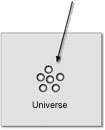 |
|
|
|
|
|
|
|

|
|
Matter
|
|
|
This something in infinite space is mass or matter. It is substance, molecules, atoms, or whatever you want to call it. Even man consists of it. And people should for once stop to lend themselves to the illusion that they are something different. They are not.
Matter: Something that exists in space, as opposed to something that doesn’t exist in space. (t.a. 2)
| The content of space is matter, which exists eternally. |
| Thetan and his perception: Existence, the own position in space, and the distance in all directions, measured from his location. |
Matter: the substance or substances of which any physical object consists or is composed. Eternal, totally undetermined, and indistinctive primal substance, which, as a primal principle of movement, is the basis of origin.
Thetan: This is the person himself, not his body or name, not the physical universe, his mind, or anything else. It is what is conscious of being conscious; an individual’s identity. The Thetan is the „I” - one hasn’t got or doesn’t possess a Thetan, one is a Thetan. The word stems from the Greek symbol or letter „theta”, which is the traditional symbol for thinking or mind.
Potentially: Possibly but not yet actually; capable of being but not yet in existence; latent.
|
|
|
|
|
|
|

|
|
Infinitely small matter
|
|
|
What was that again? If I manage to split an apple in two halves, then this apple doesn’t consist of solid, i.e. interconnected matter.
Matter is infinitely small regarding its size and volume. Let’s take any convenient piece of matter and split it in two halves. The result is two new parts, each of them half as big as the original piece. Now we take one of these new parts and once again divide it in half. Again we get two new, even smaller parts. This process can be repeated forever, until we get an infinitely small piece. And even this infinitely small piece can be further divided, even though we can’t imagine that.

| Thetan and his perception: His own size |
Atom
An atom is a tiny particle, an almost unnoticeable fragment that, with its content that is known to date, is the smallest particle of matter that we know.
A theory is not a fact. The statement that atoms have energy, that they are energetic and thus behave in a certain way, is no satisfying explanation. The question is: How does this energy come into being? The content of atoms only moves because it is stirred by other arriving particles.
The atom and its infinite fragmentation:

Fragmentation of a human being:

A limited number of infinitely small particles at a place:
 |
 |
 |
 |
| Solid |
Fluid |
Gaseous |
Vacuum |
Matter, substance, infinitely small particles, or something.
The content of atoms and its change of position within space:
If we were able to arrange an atom’s content at will, we could make any desired substance from any other substance. Maybe we achieve that in a few thousand years. Or in a trillion years.
Here’s an example, the origin of water from oxygen:
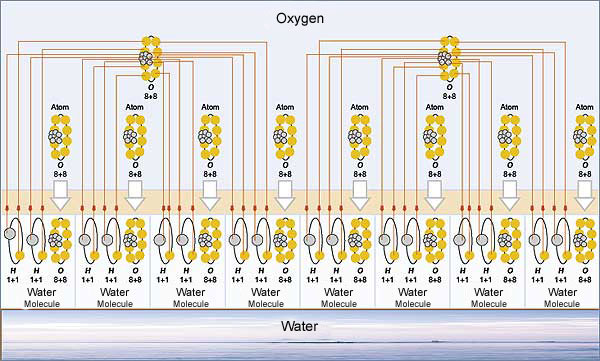
A single, infinitely small particle of matter
A single, infinitely small particle of matter within infinite space will absolutely never result in a process. That is something that doesn’t proceed, doesn’t move forward, and doesn’t evolve. Nothing noticeable for all eternity. Remaining constant forever. This one infinitely small particle of matter forever remains at this one location at which it is situated. We could of course assume that this particle had feet, wings, or something like life energy. Even if we believe in magic or declared that it was a process similar to movement, then this movement has come to a halt at some point in infinite time and in infinite empty space.

Process: Something that proceeds, moves forward, and/or evolves.
Several infinitely small particles of matter
A limited number of infinitely small particles of matter within infinite space will absolutely never result in a process either.

Only if an infinite number of infinitely small matter exists in infinite space, a very first process can and will occur.
If space is infinite, matter can also be infinitely numerous.
Now we have space, matter, and a third real something: tangency. Tangency is only possible if matter is infinitely numerous.
Here exists the primary unmoved mover, i.e. the first cause of all movement, which is in itself immoveable. This concept was already known to the Greek philosopher Aristotle.

| Thetan und seine Wahrnehmung: Andere, mehr, Anzahl, Nähe, Berührung, Entfernung usw. |
Tangency: The state of being tangent; having contact at a single point or along a line without crossing.
Primary unmoved mover: Infinitely small matter situated somewhere within infinite space, which at one point will begin moving (t.a. 10.6).
|
|
|
|
|
|
|

|
|
The first movement ever
|
|
|
The first movement ever takes place when the primary unmoved mover starts to move. In the course of this, it changes state and position. One can assume that this happens due to its unstable position compared to adjacent matter and a certain amount of shape and compression.

| Thetan and his perception: Movement, change, etc. |
Inevitably, an infinite amount of particles of matter has to consist of different shapes, i.e. their surfaces are different. Because of this, I proceed on the assumption that somewhere in infinite space and time an infinitely small piece of matter slides out of its resting state, i.e. the stable position that it takes due to adjacent pieces of matter, and starts to move.
This first movement can only happen if there is enough nothingness, i.e. empty space, around the primary unmoved mover, so that it can change its state and position within space.
Movement is absolutely necessary for something noticeable, something analogous, something fitting, for the process that something proceeds, moves forward, and/or evolves.
| Everything happens solely from the movement of matter in space |
From an infinite amount of infinitely small and spatial matter and its movement within the infinitely large and spatial nothingness, everything has happened, happens, and will happen.
Movement can only result from matter. Where there is no matter, no movement can take place. Movement happens in all directions that are not blocked by an obstacle. The movements of one infinitely small piece of matter and of many infinitely small pieces of matter happen simultaneously.
This process can only occur if there is matter and if this matter moves. If there is no matter, no process can arise. This is also valid for the case in which matter exists but doesn’t move. Matter has to exist and to move.
The first movement need not necessarily be followed by another process.
The content of space consists of matter, which either moves or does not move.
Everything moves within our universe. We move, and everything that is with us moves as well.
The first movement is the sixth something and the first process.
|
|
|
|
|
|
|

|
|
Thrust
|
|
|
A thrust occurs if moving matter encounters matter that is in a resting position, or if moving matter encounters matter that moves as well.
If the primary unmoved mover starts to move, it first hits upon adjacent matter.
To hit: To come against with an impact or collision, as a missile, a flying fragment, a falling body, or the like.
| Thetan and his perception: Noticeable and not noticeable |
|
|
|
|
|
|
|

|
|
Light
|
|
|
Light comes into existence when matter collides.
If the amount of colliding matter is too small, or if the collision happens in too great a distance, or if it is too limited in duration, the human eye cannot perceive the light.
However, if the amount of colliding matter is large, or if the collision happens within reach and is of adequate duration, then the human eye is able to perceive the light.
To collide: 1) to strike one another or one against the other with a forceful impact; come into violent contact; crash. 2) to clash; conflict.
|
|
|
|
|
|
|

|
|
Energy
|
|
|
If matter moves, or if moving matter hits upon other matter and puts it into motion as well, then the course why the matter is able to move is characterized with the word energy.
It is strange that we keep on saying that something „has energy.” And somehow it bothers me, this word HAVE.
Energy: 1) the capacity for vigorous activity; available power. 2) The capacity of a substance, a body, or a system to do work.
Power: A particular form of mechanical or physical energy.
Enery is power, and power is energy. Very funny. What does that clarify? It clarifies nothing.
Energy: 1) Energy simply means potential of movement or power. It is potential or actual movement or power (SH Spec 84,6612C13). 2) Posit particles in space. (PXL, p. 150)
Power: The ability to do or act.
Energy: 1) a word that summarizes the quality of communication, that serves communication. 2) A word that conveys why something moves but doesn’t clarify the cause of movement. It is a misleading word. The word energy lacks quality. 3) The attempt to express the reason why something is moving or is able to move. (t.a. 1-1-7)
Simply put, someone can do something because he has the energy for it. If energy is power, then why do we need the word energy? And what is this power? Power is something that is rooted in nature, something of which no one knows what it actually is. Isn’t that strange? We take the easy way out. Instead of wondering why something is moving, we just say „because it has energy, power.”
So, now someone or something has this energy, and therefore it is taken for granted that he can do this or that. In other words: He can do it, because he has energy.
If you behold something that has activity, you will see that this activity doesn’t come from it. It’s not cause but effect. A car doesn’t move because it has energy. If we assumed that it has energy, it would rust while standing. It can only be in motion if it is moved by fuel. The fuel, on the other hand, can be standing around exactly as long if nobody ignites it. It burns because its atoms have this movement that defines it as fuel. And who has put the atoms in motion? This is something that should be scrutinized before saying that something has energy or power.
| Nothing and no one has or possesses something that enables him to move. It or one is put into motion. |
If we leave it at saying that something has energy, then it is delusion. That doesn’t make sense. That’s like asking why a banana is curved and getting the answer „because it grows in Africa”. That doesn’t explain it. To declare that an item moves because it has energy or power is stultification. If someone accepts that, then he hasn’t understood, he has only adopted and is the slave of a belief.
Energy is only a bridge between knowledge and not yet discovered knowledge. Still like with Aristotle, it is a one-way-logic. The question why something can is answered with another invented word, because we have to know everything, don’t we? It is how we are, it is inherent, we have invented god, after all. It is like it is, because it is like it is. And you have to adopt that, or you can’t play with us.
Humanity slowly discovers more and more, bit by bit. And that’s okay. What’s not okay is the fact that instead of investigating further, they fabricate an answer for the not yet discovered. And worse is that which humanity has invented for an explanation always proves to be wrong or misleading later.
Okay. Man keeps on discovering and in the meantime has researched his abilities a bit further. At least I hope so.
How far have we come with energy?
Example: You have a pen. Why are you able to write? Answer: „Because I can write” or „Because I have a pen” or „Because I’ve gotten myself the pen” or „Because someone has produced this pen” or „Because someone has invented the pen” or…
How far have we come with enlightenment? Have we come to „Because I’ve gotten myself the pen”? Then “Because I have a pen” is a rather dumb answer. And dumber yet is the anwer “I can write, because I can write”.
Do you understand that? The answer „Because I can write” originates from the time before the ENLIGHTENMENT, when every desire for clarification directly came from GOD; it is like it is, because it is like it is.
Today nobody would say „Because I can write” or „Because I have a pen”, but many will say „Because I’ve gotten myself a pen” oder „Because someone has invented the pen” or … So far have we come. The answer „Because I can write” has simply become superfluous and is only good for the museum.
And what about energy? Again and again, this word is used with pleasure. In my eyes, in order to find an easy answer for the phenomenon of movement.
Energy as a problem
This energy poses a big problem. As long as we don’t fully understand what energy is, we will keep having problems with it. Dealing with this so-called energy results in man having to perform countless experiments. Especially these days he hits on problems and looks for a new energy. Do you know what this is like? It’s like a neandertal looking for fire, not knowing that by striking stone on stone he can easily make fire. Or better yet, he doesn’t know how to make a lighter.
And this is exactly what we do. In order to solve the energy problem, we are looking for energy. In order to solve the fire problem, one looks for fire. Solving the problem with the problem, so to speak. A mathematical impossibility.
A solution would be to make energy from something that lacks energy.
It is impossible to make energy from energy. This would only lead to the consumption of energy and its end.
Energy and infinitely small matter
If infinitely small matter doesn’t move within space, it either has no energy or it has energy and waits for the mood or the necessity to move.
If it doesn’t have energy, then something else needs to have energy in order to put it into motion. The question is: Where did the other thing get the energy? Nobody knows, people would have said back then, in a time when faith was still „all-inclusive”. It’s just like that. A few thousand years later, people would have invented a whole lot of deities and said that it is God’s will. Today we say that it is energy, disposition, power, talent, inherent, ability, or other strange things. You can see how abstruse all of this is.
Why do people claim that there is energy? Quite simple. Because they fail to find a better explanation for movement.
I’m in favor for making things simpler, finding superfluous data and putting them into a museum, provided that we still need them after that. Either power or energy has to go to the museum, or even both, since it is a disposition that we do not know.
Why does something move?
If we want to act smart and find an answer on why something moves, we should look for the actual answer and not just make up some word that doesn’t answer our question.
Let’s better put it that way: Something moves, but we do not know why. It is an unknown quantity.
Energy is a contrived word that is supposed to give an answer to the question why something moves, but which actually gives no answer at all. Something doesn’t move because it has energy, nor does is set free energy. This word just prevents us from recognizing the actual cause of movement.
If we say that something moves because it has energy, disposition, ability, power, or talent, we actually haven’t said with one word why it moves. We can agree of course and thus fancy that we now know why. But we do not know. None of these terms actually tells us why. Why, then, do we have so many terms?
Answer: Something moves only because it is put into motion by something else. And all these words are a neandertal’s blind, frantic search for the answer why something moves. Why not go directly to the answer?
The cause of movement are infinitely numerous and infinitely small particles of matter.
And movement itself is the result of a chain reaction. |
|
|
|
|
|
|
|

|
|
Chain reaction
|
|
|
A chain reaction occurs when matter collides with other matter, putting it into motion. This one collides with other matter in turn, putting it into motion as well.
Chain reaction: A series of events, in which each event is the result of the one preceding and the cause of the one following.
| Thetan and his perception: Joint proceeding |
Proceeding: To move or go forward or onward. A particular action or course or manner of action.
|
|
|
|
|
|
|

|
|
Empty space
|
|
|
Empty space is where there is nothingness, where there is no something. As a result, it is part of the infinite nothingness.
Empty space comes up during a chain reaction, i.e. the chain reaction creates empty space. Moving matter hits upon other matter, which is in a resting state, and puts it into motion as well. This process perpetuates, and thus empty space is created.
The more matter is involved in a chain reaction, the more movement takes place within this empty space, the bigger the empty space gets, and the longer it does exist. This movement can stretch over a relatively short or relatively long period of time. We can perceive this time as eternity, as very long, just like we consider our universe as long in a temporal sense, but it actually only consists of a fraction of this infinite time. This is why we have such a hard time imagining that empty space, created from movement and vibration, can exist in this manner. But it exists and is created in this manner.
Man is not always able to recognize, perceive, or measure movement. In many cases, movement apparently and conceiveably doesn’t exist, although it actually does take place. Example: We look at a sleeping cat. We think she doesn’t move, but she moves nevertheless: Her heart beats, blood flows through her veins, air moves the hair of her coat, etc. There is an enormous amount of movement happening within and around the cat. The same is valid on a larger scale: The earth rotates around its axis, around the sun, and around the center of the galaxy. The galaxy, on the other hand, rotates around the center of the universe. That way, there is movement everywhere in our universe, even within the so-called „empty space” or „vacuum”. Every cubic millimeter contains an enormous amount of infinitely small matter that is constantly in motion.
Empty space is absolutely necessary for the motion of matter. Here we come across something that is called freedom, slightly modified and expanded for man
Relative: Something having, or standing in, some relation to something else. Something dependent upon external conditions for its specific nature, size, etc. (opposed to absolute).
|
|
|
|
|
|
|

|
|
Current
|
|
|
If an infinitely small particle of matter moves and hits another one that doesn’t move, putting it into motion, and if this one hits another one in turn, putting it into motion as well, etc., then all the movements of these infinitely small particles of matter in total result in a current of matter. Their joint movement through space.
A current results from, and is the flowing movement of matter within a chain reaction.
A current can only take place within empty space through which it finds its way.
The current runs in a straight line, provided that it is not interrupted by another current. In this case, the current has to change direction, moving where there is no obstacle, where there is empty space.
|
|
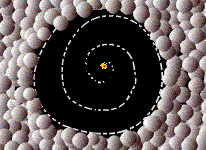 |
At the beginning, currents are chaotic, muddled, without system, without particular order, and without significant results. Later on, currents are no longer chaotic or muddled, they are systematic and with many results of great importance. They have a designated way.
A current’s course is predetermined by other currents.
Any matter within the current follows a way that is predetermined by the current.
| Thetan and his perception: A predetermined direction |
|
|
|
|
|
|
|

|
|
Place of gathering
|
|
|
The place of gathering is the part of space where a current meets the obstacles of other currents. Here it can take no other direction and can’t occupy a different part of space, thus having to end its flow.
To gather: To come together around a central point; assemble, collect, or accumulate.
Any matter that reaches the place of gathering remains there and stays in motion.
With continuous streaming, more and more matter arrives at the place of gathering. It can neither change direction nor continue its way because of currents arriving from all remaining directions. Thus, more and more matter accumulates at the place of gathering.
The fresh matter that arrives at the place of gathering moves the matter that is already located there. Thus, a great deal of motion, thrusts, and activity happens at the place of gathering. If our eyes are able to perceive this activity, they see light or fire.
| Thetan and his perception: Construction (later termed creativity), cause, or effect. |
To construct: To build or form by putting together parts; frame; devise.
Cause: A person or thing that acts, happens, or exists in such a way that some specific thing happens as a result; the producer of an effect.
Effect: Something that is produced by an agency or cause; result; consequence.
|
|
|
|
|
|
|

|
|
Compression
|
|
|
Compression is the condensing and packing of matter at a place of gathering where fresh matter continuously arrives.
The more matter is compressed the more likely it is for man to recognize it as an object. It grows and therefore becomes visible for the eye.
|
|
|
|
|
|
|

|
|
Force of gravity
|
|
|
Force of gravity is a certain phenomen that results from compression. Thus dubbed by man.
Down to the present day, we have no reasonable explanation for gravity or magnetic force. We have simply named it and accepted it as it is.
Reasonable: Agreeable to reason or sound judgment; logical.
If someone stands in the open, how many atoms from the atmoshere press on his body and thus push him to the ground? Under water, mass is even greater. On the moon, however, there is little mass, and man can leap to considerable heights there.
|
|
|
|
|
|
|

|
|
Density
|
|
|
Density is the juxtaposition of matter, with lesser or greater distance to each other, within a part of space.
If there is a large amount of matter in a confined part of space, then the density is higher, i.e. the distance between two neighboring particles of matter is shorter.
If there is a small amount of matter in a confined part of space, then the density is lower, i.e. the distance between two neighboring particles of matter is longer.
|
|
|
|
|
|
|

|
|
Glowing objects
|
|
|
A glowing object is a sufficiently large amount of matter, sufficiently compressed and condensed at a place of gathering, which exists over a sufficiently long period of time, so that we are able or not to recognize it as a glowing object.
Since there were no human beings yet when compression started, we couldn’t behold it. If we had been able to behold it, we nonetheless couldn't have seen it, since the motion of all the infinitely small matter was solely directed at the place of gathering, thus preventing any kind of visible reflexion. However, we probably could have measured it.
The glowing object is a phenomenon that also exists independently from human perception.
A glowing object can only exist as long as fresh currents arrive.
A fresh current puts any matter at the place of gathering into perpetual motion.
The more matter can be found at the place of gathering, and the larger the amount of motion, the bigger and more glowing is the object.
The less matter can be found at the place of gathering, and the smaller the amount of motion, the smaller and less glowing is the object.
A glowing object is an item of relatively high density.
|
|
|
|
|
|
|

|
|
Expansion
|
|
|
If a certain amount of matter leaves the glowing object (at the place of gathering), and if the remaining matter is able to expand spatially, one speaks of expansion.
Particles of matter from the glowing object are now able to leave the place of gathering, since the arriving matter isn’t numerous anymore to stop them.
The smaller the obstacles at the place of gathering, the easier it is for the moving matter within to evade obstacles and leave the place of gathering.
The result is less matter within the glowing object (at this place), and with it lower density.
The amount of previous activity is more and more reduced, and the activity takes a variety of different shapes.
The compression isn't high anymore. In comparison to the glowing object, it is now reduced. The amount of expansion is thus greater than the amount of compression.
Expansion always only occurs after compression. In order for expansion to occur, there has to be compression first.
If this process happens too fast or too slow, there will be no more occurences apart from decay, i.e. the infinitely small particles return to their original, unmoved state, whereas the empty space fills again.
The universe in which we are situated is currently expanding.
|
|
|
|
|
|
|

|
|
The origin of additional glowing objects
|
|
|
If the current that originates from the glowing object approaches unmoved matter, i.e. the border of empty space, it has to yield (second place of thrust in the picture). It can’t go back, because fresh matter arrives from the glowing object. It has to continue sideways. Left, right, up, or down, it doesn’t matter.
In contrast to the first phase of construction in which the first glowing object came into being at the place of gathering and the movement of the small particles went inwards from without, the movement of matter now, i.e. in the phase of expansion, goes from the glowing object to all directions.
The origin of the second glowing object
If the current that originates from the glowing object approaches unmoved matter, i.e. the border of empty space, it has to yield (second place of thrust in the picture. It can’t go back, because fresh matter arrives from the glowing object. It has to continue sideways. Left, right, up, or down, it doesn’t matter.
The current now continues to run all along the border of empty space. It ends exactly opposite of the place of thrust (second place of gathering in the picture). It can’t go anywhere else there, and a new place of gathering is formed in which mass more and more is compressed by arriving matter. Thus a new glowing object is created.
This new glowing object isn’t static. There is movement within it, and the complete glowing object moves along the border.
The origin of the third glowing object
If expansion grows a little bigger yet, i.e. if compression within the second glowing object is reduced, the particles of matter that arrive at the second glowing object are now able to leave it and move to a new position.
The particles of matter cannot move along the border because of the particles of matter that arrive there from the first glowing object. The continuing current goes a bit back toward the center, because the particles of matter that arrive from the center have no high pressure. However, soon the pressure is high enough to force the particles to yield. The only possibility is to move along the wall at a certain distance.
The origin of additional glowing objects
In the same way, additional glowing objects are created. None of them are static and they all have the same direction of motion, both rotating around their axis and in all of space.
The number of newly emerging glowing objects depends on how many particles of matter are involved. The more particles are involved, the bigger the emerging empty space, the longer it does exist, and the more glowing objects are created.
Glowing objects that we know
The space that we currently inhabit is such an empty space, containing several glowing objects. It is called outer space, cosmos, or universe. I don’t know why there have to be so many names for one and the same thing.
|
|
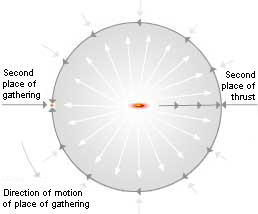
The origin of the second glowing object
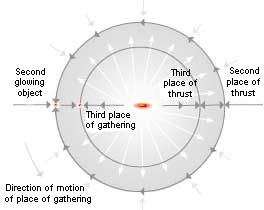
The origin of the third glowing object
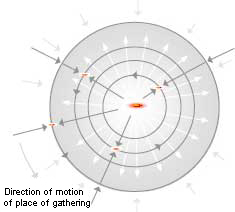
The origin of additional glowing objects |
The universe is located within a part of infinite space that is unknown to us.
I say unknown because apart from the universe every other place is unknown to us. We lack orientation within infinite space.
Universe: 1) The cosmos or universe consists of the part of infinite space that is known to us and the part of inifinite space that is unknown to us and that resembles the known part and is situated at its outer rim. (t.a. 5. D. 3Ri. 82) 2) The cosmos or universe consists of the part that is known to us and the part that is unknown to us. The known part is the one that we currently inhabit. Everything around us, what we can see and measure, and what we have recognized down to the present day, is situated there as well. The unknown part of the universe extends beyond and around this recognized border. As long as we find what also exists in the known part there, galaxies and similar thing, it is our, i.e. this universe. It is a different universe only if different circumstances from those in the known part prevail there. Regarded over a certain fixed period of time, all universes have only one consistency, and that are space and matter. All other consistencies are displaced temporally. (t.a. 5. D. 1982)
I divide the universe into two sections – the one that is known to us and that is explored, and the one that is unknown to us and that is unexplored.
The part of the universe that is currently accessible to astronomic research has a radius of more than 3 billion light years and contains approximately 10 000 billion glowing objects, also called stars. It is claimed that the cosmos is 8-13 billion years old.
The glowing objects are spread all over the universe in larger and smaller groups, whereas the larger groups are mainly located in the center. The groups form a serpentine shape that extends through the whole universe.
A single one of these groups is called galaxy. A galaxy is a group or a sytem of about 100 billion glowing objects or stars. About 100 billion galaxies are known to us.
|
|
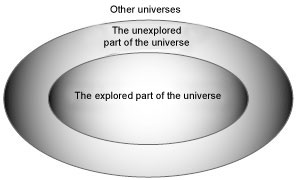 |
Since the galaxies are very far away from us, we see them as stars, and since the light they emit takes a long time to reach us, it is possible that the respective galaxy doesn’t exist anymore. In other words: One can err about having seen a star.
Glowing objects can be beheld by us as independently shining, no matter if we see them as stars or galaxies.
Glowing objects and their distances to each other
A glowing object is surrounded on all sides by other glowing objects. Each glowing object is in expansion phase one. The glowing objects emit a relatively large number of particles in all directions. The power of these particles need not be great; it can be very small in order to keep the glowing objects at a relatively constant distance and slowly move objects of any desired size.
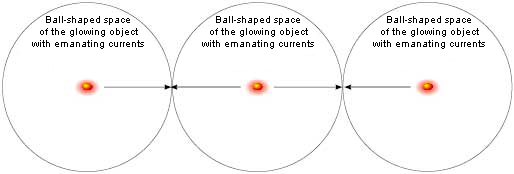
This is valid both for glowing objects among themselves and for all galaxies among themselves.
Here is a graphic display of our universe:
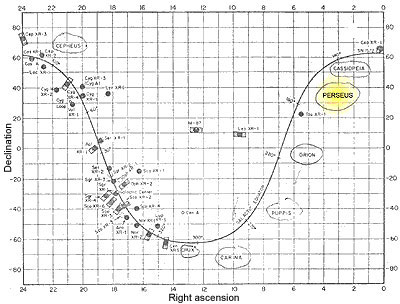
The fact that there are so many galaxies is a good reason to name each galaxy and pool them into groups in the areas in which they are located. In the graphic display of the universe, such an area, containing about 500 galaxies, is marked. The area is called „Perseus” and is nearly located at the outer rim of the known universe. One of these 500 galaxies is the galaxy in which we are situated today. It is called „Milky Way”.
Here is a graphic display of the adjacent galaxies:
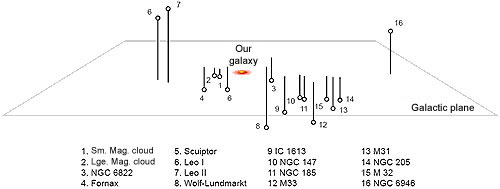
Here is a graphic display of a cross section of our galaxy:

This section model of our galaxy shows a large system of 100 billion stars, which take up space with a diameter of 60 kpe.
Of these 100 billion stars, the star that is closest to us is known as the sun. The sun is nearly located at the outer rim of the galaxy and is about 8500 pc away from the center of the Milky Way system. It takes part in the rotation of the Milky Way system at a speed of about 220 kilometers per second.
Here is a three-dimensional display of the stars that are closest to the sun:
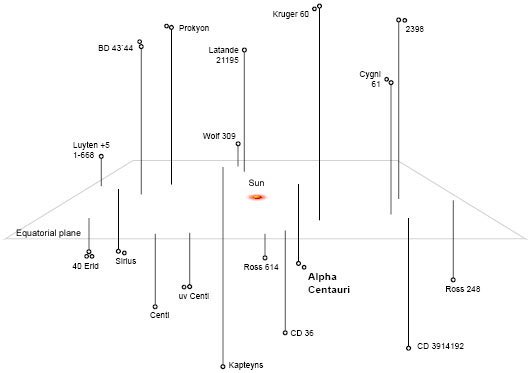
After the sun, the star that is closest to us is Proxima Centauri (Alpha Centauri) with a distance of 4.28 light years.
The origin of additional stars in the vicinity of an existing star
This two-dimensional image shows our sun and the adjacent stars. Each star emits small particles in every direction. These meet about in the middle between two stars and have to move to the side. The particles of the star that emits them cannot enter the area of an adjacent star. Consequently, they remain in the area of the star that emits them. Thus, each star has his own ball-shaped area (starball) in which a streaming of small particles takes place.
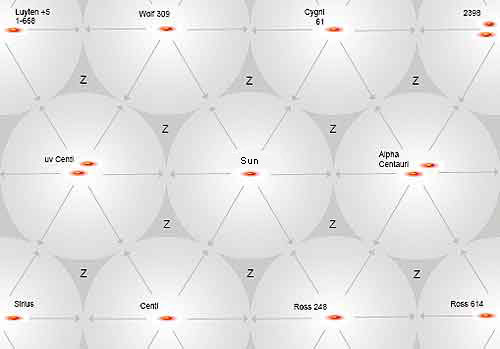
A relatively small amount of small particles leaves this area through an interspace (Z), flows out of the galaxy, and from there moves half-way between two galaxies. There they hit upon the small particles arriving from a different galaxy and have to yield. That’s the reason why neighboring galaxies have a relatively constant distance to each other. In addition, the small particles that leave the area via interspace channels cause an expansion.
Within a starball happens the same thing that happened at the beginning when there was only one glowing object in empty space. The currents behave likewise; new places of gathering and new glowing objects are created.
Here is an example of a starball with the original star and 9 newly created stars. It corresponds to our solar system back then, called star system:

Each star keeps its course because of the small particles that arrive from the original star (center) from the one side and the repulsed particles that arrive from the adjacent star from the other side.

A star system can contain a variable number of newly created stars, depending on the size of the original star.
The creation of new stars only stops if the expansion of the original star (center) enters a phase in which no more compression happens at the places of gathering, causing the places of gathering to expand themselves. That happens when the starball loses enough particles via interspace channels (Z).
|
|
|
|
|
|
|

|
|
Cooled-down objects
|
|
|
A cooled-down object is created when the current at the place of gathering ceases, resulting in a reduced amount of matter arriving. There is less compression, resulting in lesser density and less activity, less motion, and fewer thrusts. The color isn’t incandescent any more. It is a planet now, a satellite, or whatever. Even though a cooled-down object may be glowing on the inside, like our earth, which could be proof that it has been a star before, a cooled-down object is divided into solid, liquid, and gaseous matter.
|
|
|
|
|
|
|

|
|
Further notable processes
|
|
|
Two glowing objects of equal size
Simultaneous expansion. Too rapid decay. No further process
  |
Two glowing objects of different size, too close to each other
The smaller glowing object expands too fast. No further process
  |
Two glowing objects, too far from each other
Cooling down and no further process
  |
Two glowing objects of ideal size and ideal distance
When the smaller glowing object reaches the cooled-down object in cellular state, the larger glowing object is still heavily expanding.
Its current and radiation affect the smaller glowing object and compress it. In this way it receives enough momentum,
so that further processes and developments can occur.
  |
|
|
|
|
|
|
|

|
|
An example: The earth
|
|
|
 |
EA cooled-down object, the earth, was created about 4.6 to 5 billion years
ago and has a glowing object, the sun, with an ideal size
and distance in its proximity.
|
Locating the earth in the solar system (in our time)
The solar system with its entirety of celestial bodies (in the sunball) like planets, planetoids, comets, meteors, and interplanetary matter. In the solar system, the earth is, after Mercury and Venus, the third-next planet from the sun. It is counted among the inner (terrestrial) planets.

A true to scale depiction of the planets’ mean distance from the star (in million kilometers).
Like all planets, the earth moves along an elliptical orbit in whose focal point is the sun.
Earth’s speed around the sun: 29.8 km/s. The circumference of earth’s orbit is about 940 million kilometers.
Here depicted is earth’s total age:
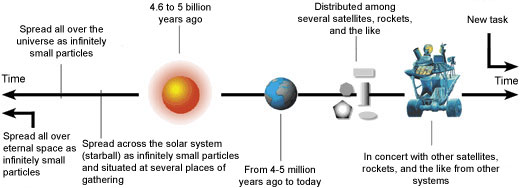
How small particles affect the earth:

When compression ceases at the place of gathering and expansion starts, and when this expansion reaches a level at which we can speak of a planet, then we have the earth. Here, primal activities still take place; small particles arrive and less move away from the earth. That way, phenomena like gravity, magnetism, etc. arise, which now no longer are phenomena. On closer examination even the activities of man, beast, and plant are the result of these two currents.

It is the particles of matter that maintain a relatively constant distance between earth and sun, that exert pressure on earth’s surface, what we call gravity, that cause earth’s rotation around its axis, and that are responsible for each and every activity on earth.
How man is able to see other glowing objects
Apart from a lightbulb or similar items that each of us knows, the sun certainly is the most well-known glowing object to us. The sun is the first larger glowing object in our proximity. One can see the sun because of the small particles of matter that, coming from the sun, reach our eyes.
One can only see something if there are enough particles of matter that, coming from what the eye is supposed to see, reach the eyes.
However, there are a lot more glowing objects that are even farther away from us than the sun. Seen from our position, they are located behind the sun. One cannot see these objects because the small particles of matter that come from them are unable to reach our eyes. They are repelled by the sun. Here is a picture for clarification:

At night, things look different. At night, one can see many glowing objects that we call stars. For one thing, we can see them because the small particles of matter that come from them cannot be repelled by the sun, and for another thing because they are much farther away than the sun, resulting in a lesser number of particles of matter that are able to reach our eyes. Here is a picture for clarification:

With the help of our eyes and technical aids we are today able to perceive countless celestial bodies as glowing spots, and no matter how we classify, label, or describe them in their behavior or characteristics, they are always glowing objects.
|
|
|
|
|
|
|

|
|
Cells
|
|
|
A cell is a cooled-down object in itself, a part of a larger cooled-down object of relative density that consists of solid matter, liquid, and gas.
This object is in expansion. The compression caused by arriving matter keeps decreasing but is still high enough to cause movement within the cell. If the expansion proceeds too fast or too slow, there are no longer any processes apart from the cell’s decay. One could also say that the cell dies.
Various terms for cell: Bacteria, C, O, H.
Origin of the word „cell”: A small room of simple furnishing within a building that is intended for persons (e.g. monks or prisoners) who live there separated from others. The cell is a constructional component of all living creatures. The cell moves and is put into motion. Certain cells release a secretion, called hormone in this case, that other cells use for moving.
Life: 1) The condition that distinguishes organisms from inorganic objects and dead organisms, being manifested by growth through metabolism, reproduction, and the power of adaptation to environment through changes originating internally. 2) The sum of the distinguishing phenomena of organisms, esp. metabolism, growth, reproduction, and adaptation to environment. Life is tied to the cell as outer shape and to protoplasm.
To survive: To remain alive after the death of someone, the cessation of something, or the occurrence of some event; continue to live.
Protozoa are the smallest living unit, e.g. bacteria, many algae, and fungi.
|
|
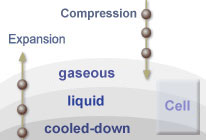
 |
The Thetan and all his perceptions to this point are enough to, by modifying, understand and control any time in which he will exist
and any shape that he will take, if the time in which he exists and the shape that he takes provide this possibility for him. |
To modify: To change somewhat the form or qualities of; alter partially; amend.
Closing word
Whenever we study cells, and whatever new things we discover, if we keep on studying, we always arrive at the same common denominator: They are small units that get a job done together. As far as we know, these small units are always matter, i.e. atoms, which more and more lead to infinitely small matter, provided one keeps researching them and discovers their actual components.
Essential matter of a cell, and thus of life including humanity, is:
| Phosphorus P |
|
Oxygen O |
|
Hydrogen H |
|
Nitrogen N |
|
Carbon C |
|
|
|
|
|
|
|

|
|
Multicellular organisms
|
|
|
Multicellular organisms are two or more cells that are in contact to each other.
If the expansion proceeds too fast or too slow, there are no longer any processes apart from the cells’ decay.
Various terms for multicellular organisms: Organs …
|
|
|
|
|
|
|

|
|
Organism
|
|
|
An organsism consists of several organs. It is a greater whole.
If the expansion proceeds too fast or too slow, there are no longer any processes apart from the organism’s decay.
Various terms for organism: Plant, animal, human …
|
|
|
|
|
|
|

|
|
Plants
|
|
|
A plant is an organism that consists of a limited amount of infinitely small matter and a part of nothingness within a part of infinite space.
Infinitely small particles of matter are in contact to each other. Some of them leave the plant and expand. New ones arrive and are compressed. Some particles of matter leave the cooled-down object by finding an unobstructed way through the plant and thus keep expanding. The plant causes a further expansion by breaking up cooled-down objects, atmosphere, and minerals. By dying, it then expands itself. If it is burned or eaten by man, it expands more quickly.
If the expansion proceeds too fast or too slow, there are no longer any processes apart from the plant’s decay.
If the expansion is too fast or too slow, then there are no longer any processes apart from decay.
|
|
|
|
|
|
|

|
|
Animal
|
|
|
An animal is an organism that consists of a limited amount of infinitely small matter and a part of nothingness within a part of infinite space.
Infinitely small particles of matter are in contact to each other. Some of them leave the animal and expand. New ones arrive and are compressed. Some particles of matter leave the cooled-down object by finding an unobstructed way through the animal and thus keep expanding. The animal causes a further expansion by breaking up cooled-down objects while eating and digesting, i.e. it breaks up the physical universe. By dying, it then expands itself.
If the expansion proceeds too fast or too slow, there are no longer any processes apart from the animal’s decay.
|
|
|
|
|
|
|

|
|
2.5 to 1 billion years ago to the year 2007
|
|
|
Protozoa, the most basic form of life. Subkingdom of animals (animal protozoa) with about 40000 known, roughly 1 to 2 mm long, recent breeds. A considerable number of protozoa are able to survive adverse living conditions as perpetual states (cysts).
The basic component of a plant's inner organisation is the cell. The primal plant groups on the organizational level of algae are protozoic, form loose cell colonies, or have a simple filamentous or lobed vegetation body (thallus).
Algae are protozoic to metazoic. They have existed for more than a billion years.
The first land plants are known from fossils from the turn of the Silurian to the Devonian about 450 million years ago. The oldest angiospermous seed plants developed in the cretaceous age about 125 million years ago. They drove off the by then prevailing conifers and ferns and are the dominant group of plants today
About 38 million years ago
Dawn of the human evolutionary line. Great apes, ape-like forms.
Inherent features: Existance, touch, motion, thrust, body, sensory organs, very pronounced
reactive part of the mind, less pronounced analytical part of the mind, communicational drive, lowly sublimating creativity, sex, etc.
Since motion and thrust are part of their instincts, they utilize stones and other things and thus amplify expansion. |
|
 |
History of development: The human evolutionary line starts with ape-like forms (Propliopithecus and Aegyptopithecus) of the early Oligocene (about 38 million years ago). There exist remains of several human-like forms from the lower Miocene (17 to 22 million years ago), of which Proconsul africanus is best documented by findings. Homo habilis, who arose 2.5 million years ago, is placed at the beginning of the evolutionary line that led to modern man. Basically, he is accredited with the production of stone tools (»pebble tools«). In detail, the stages of development are contentious. However, there is no doubt that the two-legged posture and way of locomotion were developed first. Only afterwards followed the cerebral evolvement to a level, which is far higher than that of other great apes.
About 1.5 million years ago
About 1.5 million years ago (or even earlier), Homo erectus appears, to a large extend having modern man's physique. It was this breed that for the first time left Africa and spread out to Asia and Europe. Skilled in the production of tools (stone axes, flakes) he developed the ability to build a fire and to successfully hunt larger game. From here, the development went over an early archaic and a later archaic form to the Homo sapiens, whose skull configuaration basically doesn’t differ from that of modern man anymore. By bone finds, Homo sapiens is documented to have existed in Africa (southern Ethiopia, South Africa) for more than 100000 years. From there he spread over south-west Asia to Europe, where he (according to recent theories) presumably intermingled with the local population of archaic Homo sapiens and later replaced it.
|
|
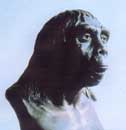 |
At least since the beginning of the last interglacial (about 125000 years ago), Europe and Africa had been populated by the neandertal, who vanished 30000 years ago and was replaced by the Homo sapiens. The neandertal is often considered as a form of archaic Homo sapiens that was particularly adapted to the living conditions of the ice age and that in anatomical terms, apart from the development of the skull, was very similar to modern man.
5 to 1 million years ago
Plesianthropus and Australopithecus – interstages between ape and apeman. Animal-like horde creatures. They employed stones and sticks as weapons. Life was commanded by instinct. Existance was random. Communication similar to animal sounds.
About 2.5 million years ago
Homo habilis is put at the start of the evolutionary line that has led to modern man. The two-legged posture and way of locomotion were developed first. Afterwards followed the cerebral evolvement to a level that is far higher than that of other great apes. Production of stone tools.
|
|
 |
About 1.5 million years ago
To a large extend, Homo erectus had the physique of modern man. This breed was the first to leave Africa and spread to Asia and Europe. Skilled in the production of tools (stone axes, flakes) he developed the ability to build a fire and to successfully hunt larger game.
About 100 000 years ago
Homo sapiens, whose skull configuaration basically doesn’t differ from that of modern man anymore, is documented by bonefinds to have existed in Africa (southern Ethiopia, South Africa) for more than 100 000 years. From there he spread over south-west Asia to Europe. Religious concepts. First works of art, cave-paintings.
About 30 000 years ago
For the last 125 000 years, Europe and Africa had been populated by the neandertal, who vanished 30 years ago and was replaced by the Homo sapiens.
20 000 years ago
Magdalenia stage; man and environment correlate.
10 000 years ago
Autonomous thinking, thoughts about life and death, as well as observance of natural events.
6500 years ago
Early civilizations in Egypt and Mesopotamia. Farmers and herdsmen; hunting is replaced.
4241 years ago
The first scratch-like characters; hieroglyphs.
3100 years ago
Greek and Roman antiquity. Two world systems had been developed in the classical world that featured earth as the center of the universe. They even remained valid during the middle ages. For the Greek philosopher Aristotle, the world rested amidst concentric spherical bowls in which the seven planets, including the sun and the moon, were set.
Not more than 41-47 generations, based on a mean age of 65-75 years.
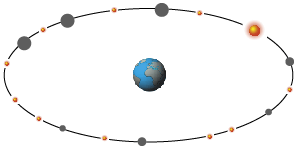
| The earth as the center of the universe |
About 2570 years ago
Pythagoras, a Greek philosopher, teaches that the figure is the nature of reality and advocates the doctrine of transmigration. Mathematics, astronomy, and acoustics owe important insights to the Pythagoreans.
2427 years ago
Plato, a Greek philosopher from Athens, advocates the One (God) that is above all regulations and from which all forms of being originate, not by creation but by essential emenation. A mono-logic.
2384 years ago
Aristotle. His last will, which shows a loving care for his surviving dependants, is delivered to posterity. The delivered composition contains the areas of logic and epistemology, natural philosophy, metaphysics, ethics, politics, oratory, and theory of arts. He is objective, businesslike, and brief, and, where necessary, coins new words.
1588
Tycho Brahe. A new, geo-heliocentric world view is created: The other planets move around the sun but with the sun around the earth, which retains its centric position.
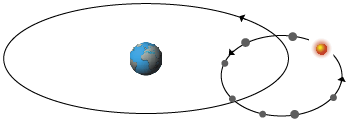
| A geo-heliocentric world view |
1564
Galileo Galilei. He was the first to watch the sky through a telescope, making sensational discoveries in the process, and initiated modern astronomy. In general, Galilei is considered as someone who was punished for going against the stream of philosophical-religious doctrines and describing nature as he saw it.
„And yet it (the earth) moves.”
A new stringent way of thinking and discussion arises.
1718
Newtonian axioms: Every body perseveres in its state of being at rest or of moving uniformly straight ahead, except insofar as it is compelled to change its state by forces impressed.
1596
Renatus Cartesius. He establishes his perception of truth, both as a pure evidence gathered by intuition and a clear, distinct conception (undoubtedly true is what can be discerned by reason, »clare et distincte«), as well as for the fundamental distinction between two substances: the „Res cogitans” („thinking substance”, the world within) and the „Res extensa” („extended substance”, the external world), which in physical coherences follows the reduction of the physical world to sheer extension ("extensio").
„I think, therefore I am.” Here, nature's reduction to sheer extension takes a key position.
Descartes not only influenced the followers of the Cartesianism (in medicin, among others) but also philosophers like J. Locke, G.W. Leibnitz, B. de Spinoza, L. Wolff, and I. Kant.
1879
Albert Einstein. Based on fundamental criticism of the measurement of time and space, he developed the special theory of relativity in 1905. From it, he deduced the law of inertia of energy.
Theory of relativity: Time lapse isn’t simultaneous everywhere, space is bended, and he who moves faster ages more slowly.
A designation of time is always relative to a certain frame of reference. The concept of absolute time is an illusion.
Time
One cannot argue that the earth takes a certain amount of time to circle around the sun once. The earth does take a certain amount of time to circle around the sun once. If we go from A to B, we also need a certain amount of time. A moment has a certain duration, time. And several moments, successive or non-successive, also take time. Every movement takes time. Even a non-movement has a duration of not moving, a duration of its existance. As long as there is space, there will be the time of this space’s existance. And as long as anything exists in space, no matter what happens there or not, time will exist. Even if it didn't exist, there would be time that lapses. Time is always there, it is always identical; it has the same length and the same duration.
Time in itself isn’t relative. It’s no illusion and it’s not an absolute time. Moving from A to B takes a certain amount of time, and this time is absolute time. It takes so and so much time, no more, no less. If man, as an imperfect creature, tries to comprehend, describe, measure, or perceive this time, then it’s subjective and thus relative; it’s an illusion and no absolute time.
Relative is how man interprets time. If someone says something is fast, it can be slow for somebody else. If someone says „that’s a long time”, it can be a short time for someone else. If we say that the earth takes 360 days to circle around the sun once, it is our measurement of time. We modify time, the motion of earth, with the time of a day.
Man has little comprehension of time itself, hence he needs comparisons.
1961
Juri Alexejewitsch, Soviet pilot officer, cosmonaut, born 3-9-1934 in Kluschino (region Smolensk). His plane crashed at Nowosjolowo (region Wladimir) on the 3-27-1968. On the 4-12-1961 he circled around the earth as the first human being in a „Wostok" spacecraft (1h, 48 min).
1969
On the 7-20-1969, the first landing on the moon succeeded with Apollo 11, carrying Neil Alden Armstrong on board.
| Humanity restricts further development of space travel |
The next goal in humanity’s exploration of the solar system should have been the planet Mars. However, political leadership’s priorities had shifted in the meantime. Even the glamor of the Apollo mission couldn’t convince president Nixon or the broad american public to provide enormous amounts of money for an aggressive programm of manned exploration of Mars.
1980
Over the course of the 80’s, two completely different developments became apparent. For one thing, space technology became increasingly important for daily needs like the global communication via satellite or weather observation from space. Beside that, endeavors gained steam to increasingly utilize space for military purposes.
| Indirect development of space travel |
1982
During that time, the Soviet Union concentrated on the construction and operation of space stations in proximity to earth. There, the cosmonauts learned to live and work under the adverse conditions of a sojourn in space for timeframes of one year or more.
1996
Mars. The sending of the American space probes of the Mariner and Viking series, the Soviet Mars probes, as well as the mission Mars Global Surveyor (start 1996) made it possible to fotograph and catograph the surface of Mars. By means of the probe Pathfinder (1997) the ground of Mars was chemically analyzed for the first time. According to that, it seems to be a weathering product of basaltic volcanite. The NASA space probe Mars Odyssey (start 2001) also conducts geochemic-mineralogical examinations of the surface of Mars.
2007
Today, this day, the present day; the day that currently proceeds.
If the expansion proceeds too fast or too slow, there are no longer any processes apart from decay.
If humanity continues the age of space travel, they have a chance to survive. If they do not continue it, this chance doesn’t exist.
However, humanity will continue the age of space travel, even if the result is great harm.
|
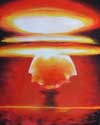
t.a.
|
And then, when you think we live in peace ... then it comes ...
A civilization without insanity, without criminals, and without wars, where the skilled can be successful and where honest beings can have rights, and where man has the freedom to rise to greater heights – that should be our goals.
Ideas, not battles, indicate the progress of humanity.
An examination of all this has shown that at any time on earth there weren’t more 10 000 people who had the markings of leadership … There are actually only about 10 000 of them.
| Danger of atomic destruction |
|
|
|
|
|
|
|
|
Toni All © All rights reserved.
|
|
|








































